IMPRESSIONS
FROM CHINA 2 - JULIA STEINER
by Michèle Vicat
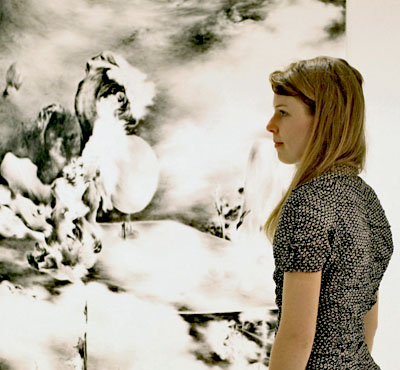
JULIA STEINER, photograph by Lucinda Dowell © 2010 |
We are honored –and that is not an exaggeration - to have been invited in Julia Steiner’s studio in Bern, Switzerland. Tears came to my eyes when she explained that she captures in her work “little things of life like the light falling on the floor” or “how the wind is going through things.” Suddenly, the world is in front of you, personally, although it is not as simple as that. Julia Steiner helps you to cross the bridge of the unknown, to assemble emotions that are deeply imprisoned in your soul, to have courage.
Born in 1982 in Büren zum Hof in Switzerland, she studied Applied Art and Art History in Bern and Berlin, and also obtained a degree in art education. Her parents thought that she needed to have a secure job – teaching art for example, but not depending on art. She is, today, at age 28, the recipient of several international awards. In 2010, she spent six months in Beijing as the artist in residence at the Galerie Urs Meile in the Caochangdi district. There, Julia Steiner produced work that was exhibited in the gallery under the title “A Tense Turn.”
She now has an exhibition, called Kaleidoscope, in the city of Biel/Bienne, Switzerland, at the Kunsthaus CentrePasquArt/Centre d’Art. The show runs through June 12, 2011.
The following interview was made in her studio in Bern in March 2011.
Your medium is gouache on paper. Why did you make that choice?
I think it comes from the fact that I never painted. I always used pencils and charcoal and I drew on paper. For me, it is the drawing that counts. First I made drawings, but I wanted to do it on a large scale. I looked for ways to do this: how I can fill in large-scale paper. If you use pencils, the process is very slow. I knew I did not want to use oils or another kind of painting. I was looking for something that could be used on a larger scale than pencils but that also would leave traces, but not like a pencil, which is very pointed and precise. I discovered brushes and gouaches. But I do not use water. I use gouache in a very dry way. It is more the pressure of the brush into the gouache that counts. I just need a little bit of color and it is dry when it touches the paper.
You never painted?
Yes, a little bit at school. But I never really painted. It was more like drawing.
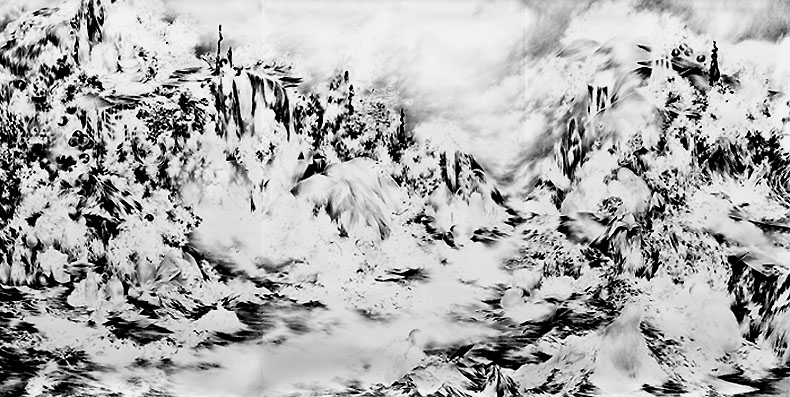
"Agglomeration," 2010, gouache on paper, 230x456cm, courtesy of Galerie Urs Meile, Beijing-Lucerne |
You did a residency for six months in Beijing last year. It was your first visit to China. What did you do there?
I had a studio and I wanted to continue my work the way I am doing it here. I did not want to do something new. I just looked around and had impressions of what I saw there. But, I went on with my work. I like to work in a continuous way. My first preoccupation was to find paper. I also traveled in East China.
As a whole, how was the experience?
It was great! For my work, the studio was next to the gallery. I could rely on them if I needed anything.
The first time I saw your work was in a group show at the gallery Rosa Turetsky, in Geneva. I did not know anything about you, but my impression was that there was something very Asian in your composition and your sensitivity. At that point, Rosa Turetsky told me that you were in Beijing at that time. Were you inspired by Asian art before going to China?
No, because I did not know anything about Asian art. But several people asked me before if I had a relationship with Chinese ink painting. I did not know anything about it. Then, I started to read about it and I started to find some relationships, but more in a philosophical way. That was enough to intrigue me and I was interested in that art form from then on. So, I decided to go to China and to have a look.
I always drew like that and worked like that. But afterwards, I started to think about it and to have a sense about the way of thinking in China, mainly about Taoism.
For me, it was not the use of black and white or the resemblance to ink painting that made me think of an Asian inspiration. It was more the organizing of the space and how you lead people into it.
At school in Bern, I had a mentor, a great teacher with whom I could freely talk about my work and I found out later on that he, himself, was interested in Taoism. But he never mentioned that to me. He never oriented me to Chinese painting. Now, we can talk about it.
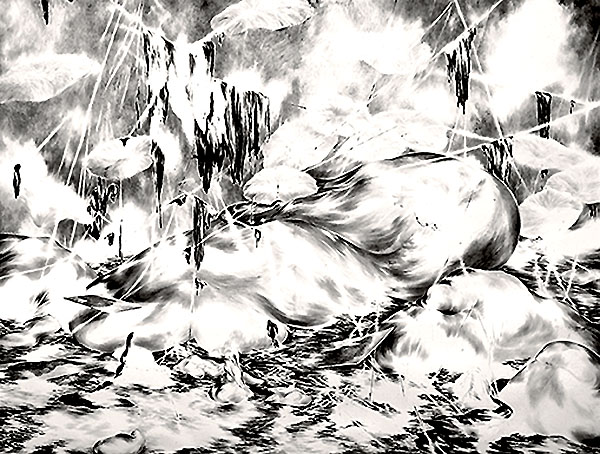
"Lotus," 2009, gouache on paper, 230x304cm, courtesy of Galerie Urs Meile, Beijing-Lucerne |
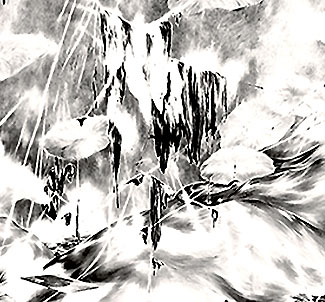
Detail of "Lotus" |
How did you feel about Beijing? It is quite different from Bern!
On my way from the airport, I saw a man on a motorbike with huge tree branches on the back. It was amusing to see a means of transport so different from Switzerland. Then, in Caochangdi, the little places where people were living and cooking, nearly in the street.
At first, I did not realize the size of the city. Here, everything is so near. It does not take an hour to do something. The first time I wanted to go from Caochangdi to the center of Beijing, I needed 2 hours!
When you were there, did you go to museums, did you visit the studios of other artists?
I did not do too much of that. I visited galleries, I saw a few museums in Beijing. I was disappointed about the exhibitions there, because the standards are different. The light is usually not good in the galleries.
I did not see a lot of artists’ studios there. I did meet most of the artists of the gallery that invited me. Otherwise, I did not have a lot of contacts with artists. I met a young painter, Guo Hongwei, because I like his work very much. Otherwise, I did not have a lot of contact with other artists. I think it was mainly because of the language. When somebody could translate it was O.K.
Did you feel isolated during the 6 months?
Not really, because I had my work. But that is the way I am. I like my work and I always work alone. I walked in the streets and looked around. I was curious to see things, but I did not feel isolated.
You would say that it was a positive experience there?
Yes, even if I am not sure what I learned there, what influenced me there. May be I took more energy there. I can feel now that I want to work with larger and larger papers and dimensions. But as a whole, I still do not know what experience I got there. I do not know what is there yet. I can feel that there is more flow in my work, more wind.
How did you start…with small formats, and then bigger ones?
No, before, I was drawing in my notebooks. I did not do pictures to hang on the wall. I drew everything.
Where does your inspiration come from? What part does nature play?
It is from nature, but mainly from everyday observations. Little things like the light falling on the floor. How the wind is going through things. Such things. Not big ideas. It is like the flow of nature, but also how things are coming together in a material way. It is a lot about space.
Let’s look at one of your compositions. This one, Growth (Gravity Play), is one of the latest?
Yes, from last month.
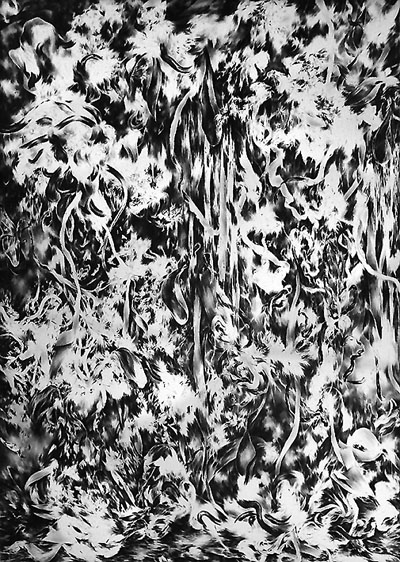
"Growth (Gravity Play)," 2010, gouache on paper, 287x203cm,
courtesy of Galerie Urs Meile, Beijing-Lucerne
(Click on image to enlarge. Use browser back arrow to return to text)
|
First, you have a piece of paper…and I must say quite a huge one! How do you approach this paper? Is there a unique way you start all your projects? You start by doing a small drawing in a notebook like you did earlier?
No, I do not do sketches any more. Sometimes, a write a few words on a piece of paper. I use words, verbs as a working instrument. Even on the big paper: I do not do any preliminary sketch.
How does that work? When you are in front of a big piece of paper like this one…
I start!
Do you have a way of starting or does it change every time?
I used to start in one place. I had an idea of an object, a fragment of something and I started with that. Then, it grew all over the paper. But for the last two years, I haven’t worked like that any more. Now, I go all over the paper first. I start with small traces and then it becomes denser. Things grow together.
Before, I often started in the middle of the paper and it grew outwards. Now, it is more like growing from the outside towards the middle.
Why?
I do not know. In my earlier works, I had more ideas before I started working. I knew that there was something that interested me and I drew from that. Now, when I start, there is more like an abstract feeling or an idea that I cannot really explain. It is more like catching it from all over!
Did any artist influence you? Or did you study some artists more thoroughly at school?
Not really. I studied art history at the university. I saw a lot of work. I never had a favorite artist.
Your work is fascinating. What is your approach?
I think it is more a dialogue between the picture and myself. When I start, there is something but I really do not know what it is. It starts, I feel it and then the picture comes while I am working. It is like I did something, I look at it and then there is a reaction. I look at what I have done and then it goes on. I can start with an idea and at the end it may not be the same. It changes a lot when I draw.
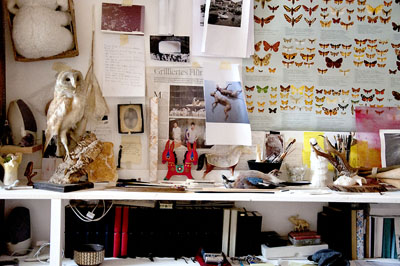
Shelves in the studio of Julia Steiner, (Click on image to enlarge)
photograph by William Dowell © 2011 |
Mainly, you are doing abstract landscapes. Have you ever been interested in drawing people?
Yes, in my early work. There are more people and animals. There are things you can recognize. Now, they are disappearing. There are more fragments of bodies. I am not working with whole persons any more.
Why?
My interest in people was never about showing a person. It was more to have a bodily presence. It was more to have the tension of the body in the whole of nature. It is a relationship. I do not need a whole person for that. I do not need that person. It is more like a figure. It is more like an energy, a spirit of a person.
Do you usually give names to your compositions?
Yes. Naming a work is very important since I use words as a working instrument. The title comes from this writing process. But, today, I am not writing words any more to start my work. It will be more to find one word and another one that are describing the process and do not necessarily have a connection. I do not like titles that tell you about the work. People are influenced. They think this is this or that and that you have to see that.
But I like names because the work has a face.
Do you want to pursue your work only with paper and gouache?
I did some experiments with silk. It was not as free as using paper. I also tried canvas but it did not go anywhere. I experimented with printing like heliogravure and lithogravure.
For me, the technique has to be like an instrument and not the topic of the work. I like paper and gouache because I can do anything I want with this technique.
Why was it difficult to work with silk, for example?
Because of the structure of the silk. It is moving all the time. The difference between the shades of gray is difficult to obtain on silk. Normally, the people who use silk use water. I work with pressure on the material.
I also did some experiments with colors. But, I did not know which color to take. Black and white are the colors that offer me the most possibilities. You find all the colors between black and white.
I tried a monochrome color like blue, but I did not like it. For me, it became more decorative.
Why did you pick the name for this painting?
Growth (gravity play). It is about falling gravity.
How do you work? One panel at the time or do you handle several at the same time, because I can see many panels next to each other in your studio.
I work back and forth. One day, I work on one painting. I need time to find out what I will do next. I start and I leave it. It hangs and I look at it while I am working on another one.
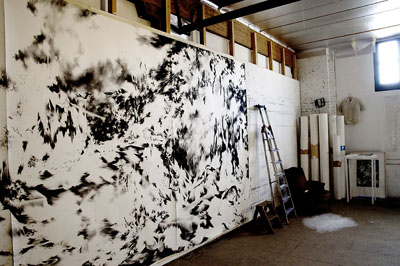
Work in progress in Julia Steiner's studio, photograph by William Dowell © 2011 (Click on image to enlarge) |
How do you manage to find your own balance, your own equilibrium going like that from one composition to another one?
I often like to change after a while, otherwise I am too close to it and I do not see how to move. I need this rupture. I can look at it, turn around, look at another one, come back to the first one. Then I see it and I know what I have to do next. If I work 10 hours on a drawing, I do not see it anymore. I come in, and then go out. It is the best thing to do, like at night, I go out of my studio.
How do you handle that? It is monumental in its physical and emotional dimensions? Do you take breaks?
I am not good at that, taking breaks. I go every day to my studio and work hours. It is a condition that I build. I need to go to my studio every day and work.
When did you finish your studies?
In 2007.
What is your feeling about nature today? What will happen to nature?
My work is a lot about nature, but also about the energy of nature. It is also about the destruction of nature.
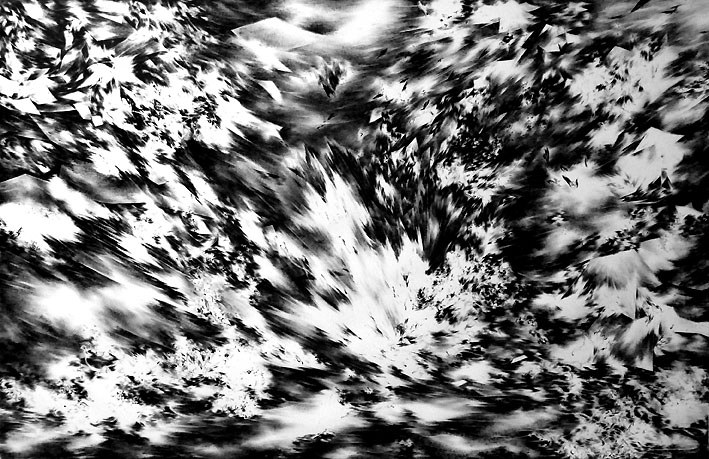
"Impact" (fragment), 2011, gouache on paper, 150x230cm, courtesy of Galerie Urs Meile, Beijing-Lucerne |
Today, many artists are doing landscapes, but they are toxic landscapes. Do you feel that way?
My compositions look like landscapes, but they could also be a construction site or a mixture of nature and a construction place or an accumulation of trash. In Caochangdi, I was very interested by the trash in the street. There is a lot of trash there. It is an accumulation. Everything goes in the street. It becomes like hills. Once a week, a big truck comes and takes all the trash away. In a way it was ugly but in another way I was fascinated by it because it forms a kind of landscape too.
In my landscapes, it is not about virgin landscapes. At first, it can look like a landscape, but then you have built objects. Like the flea market in Beijing. Everything was on the ground. There were big collections of things. They were also landscapes in a way.
I am interested in how things come together, how they are connected, how the space works between these things, also the direction of the wind, gravitation.
How would you describe your own perspective?
You could say it is like a Chinese painting. It is a view that is not seen from one point. You have to go inside it and then the space turns around it. There is a behind and beyond, a back and front at the same time. But, all of that can change at the same time.
It corresponds to our world today. We are not functioning on one plane anymore.
The show in Biel, Switzerland, is called Kaleidoscope. I like this word very much because it means turning around and changing the view constantly.
What do you have in your notebooks on the shelf?
Drawings, notes, words. Collected things like a leaf from a tree. It is like a diary, but in a working way, compiling more impressions especially when I travel. When I am in my studio every day, I do not use a notebook often.
What do you think about Chinese art and what it is bringing to the rest of the world?
For me, it is not important where art comes from. I do not think about Chinese art really. When they started to do art the way we consider art, it was quite different. All the things I saw there was big, huge. They have a different way to work, to produce art.
Did you see things differently after you came back from China?
Yes. I saw the way they produce art. This is a part I did not really like. Big fabrication with a lot of assistants. I am working alone every day! They do so many things at the same time. Personally, I cannot think like that.
Is there anything that particularly struck you when you were there?
I like Qiu Zhijie and Yang Fudong. I like their poetical way of showing things. It is not like “ It is here and you have to see it.” There is more mystery in their work. Both work a lot in black and white and somehow, I like that!
If you do something like a factory, it is no longer interesting.
Someone like Guo Hongwei does not do “Chinese art”. He takes his inspiration from everyday life. He belongs to a new generation of artists with a high sensibility and who does not enter into art mass production.
|